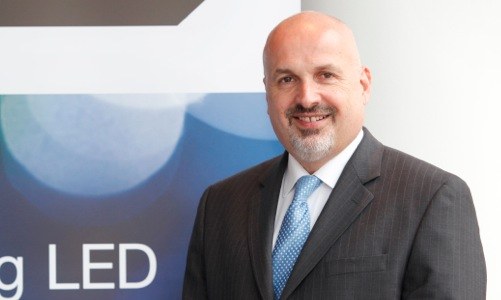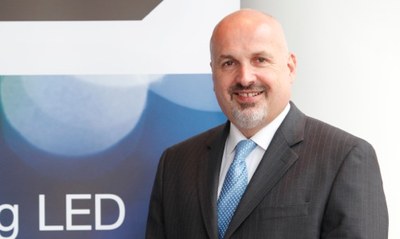Zhaga - Insights into the New LED Lighting “Standard” for Light Engines
Greg Galluccio, Director of LED Business Development and Product Management for Lighting and Energy Solutions at Leviton and Zhaga spokesperson, talked to Siegfried Luger and Arno Grabher- Meyer from LED professional at the Light+Building in Frankfurt about the Zhaga LED lighting “Standard”. The industry initiative, Zhaga, will fundamentally influence the lighting business because of the interchangeability of LED light engines.
Greg Galluccio is Director of LED product development and lampholder product management for the Leviton Manufacturing Company. His experience spans 32 years in the electrical products industry with expertise in product safety and standardization, engineering management, new product development, marketing and business development. Mr. Galluccio is currently serving as Leviton Manufacturing Company’s lead liaison to the Zhaga Consortium.
LED professional: What was the reason for establishing Zhaga? What is the history of this industry initiative?
Mr. Galluccio: The name Zhaga was chosen arbitrarily so that it can’t be confused with anything else in the industry. The organization came about because the lighting industry as a group simultaneously realized that the lack of interchangeability of LED products was a major problem for the promotion of LED lighting. The lighting industry has been operating in a completely interchangeable way for the past hundred years. For example, if you have an E27 socket, you can take the bulb out of it and replace it with another one. Unfortunately these sockets don’t have the heat exchange capability and some of the other electronic delivery capabilities that are needed for LED lighting. Therefore, when it came to commercial products there was no interchangeability. This causes a great deal of concern on the market. The luminary manufacturers are asking themselves if they should really invest in LED lighting because when they use a certain light engine with a specific form factor it’s possible that they will have to change the reflector and fixture design six months later.
About ten of the larger companies initiated Zhaga but there were already 30 companies attending the first meeting in February 2010. There are now 192 members and 55 of those have full membership with voting rights. The remaining 137 are associate members. They have access to the data and can attend the meetings.
LED professional: What is Zhaga’s strategy and roadmap for specifying LED light engines?
Mr. Galluccio: The main point that Zhaga is trying to address is the interchangeability in geometric requirements. We do not specify quality of light output, safety, end-of- life or any other things that are covered by other standards like the IEC. Our goal is to make sure that within this interchangeable device there is still the freedom to design any kind of technology. In this way you could have a device that has very low CRI or other performance figures because it might be better and cheaper in the application. On the other hand, you can design the same module with the same form factor that has very high performance values appropriate for the application. So we have created a total of seven specifications which are known as books. These are the specifications for different application modules including the control gear like a complete spot-light module. One of the books available is for general specifications.
“We don’t want to limit the diversity and the potential of the LED medium. We have to be very careful about that. We’re only trying to facilitate the commercialization of the product by easing the interchangeability”
Greg Galluccio
LED professional: Is there also an electrical specification?
Mr. Galluccio: We do specify the dimensions for internal and external drivers but we don’t specify, for example, the LED driver currents.
LED professional: Are these seven books the final specification or are there thoughts on expanding?
Mr. Galluccio: Right now, there is nothing new on the table. The process that we use is that the member companies come to us and propose a different enough application which the consortium will then review. The other thing that is necessary in order to work on a book is that enough companies are willing to actually participate and create a product according to the new applications.
There is one more book that is being written about dimming characteristics. We are trying to specify dimming curves and the ability of the dimmer- interface within a certain number of parameters with the Zhaga modules.
LED professional: Can you tell us more about dimming? You mentioned dimming curves. Are you talking about different curves for different applications?
Mr. Galluccio: Yes, there are different dimming curves proposed for different applications and there are ranges within those curves within which the dimmers should operate. We do specify a line with a tolerance as dimming curves. The curves are also specific to the different types of dimming such as 1-10V, DALI or TRIAC dimming.
LED professional: It seems that some of the books are related to existing products from well-known manufacturers. Are these manufacturers very influential?
Mr. Galluccio: Yes. However, we do have many small companies, especially from Asia, participating. Each company only has one vote. So the process is also very attractive to the smaller companies.
LED professional: But the larger companies also reveal knowledge about their modules. How does that work?
Mr. Galluccio: Part of the Zhaga agreement, when you join, is that any form factor technology you introduce to the group is free and clear of royalties. As soon as you bring a design into the group there is no protection any more. Access to the standard is limited to the participants at the beginning because they are spending a lot of money and resources to help develop the standard. It is only fair that they should have first access. However, over time, these standards will be available generally.
LED professional: What is the market feedback about Zhaga? Have you seen any results yet?
Mr. Galluccio: The market is only just seeing this now but I think the reaction will be very positive for a number of reasons: First, the luminary manufacturers can now design their products based on certain dimensions. Second, people can plan and roll-out lighting schemes based on Zhaga modules knowing that they will get corresponding parts in years to come.
LED professional: How do you get a certified Zhaga module?
Mr. Galluccio: Certification is one of the topics Zhaga is working on right now. The Zhaga logo on a product signifies that it has been tested and certified by a third party in a certification organization. We created a process by which lighting laboratories can apply for and become recognized laboratories. Unfortunately, right now there are only three: UL, DECRA and VDE. In the meantime, we’re trying to expand this certification network.
LED professional: As far as we have heard, these laboratories don’t have the resources to cover all the enquiries. Is this true?
Mr. Galluccio: What has happened here is that there is a bottleneck. We only just finished our accreditation of these laboratories 3 months ago and as soon as they were authorized to do the testing, everybody submitted their Zhaga modules. Once the bottleneck clears, though, we’ll see more and more products getting certified.
LED professional: What will be tested during the certification process?
Mr. Galluccio: There are gauges to check what fits and doesn’t fit the product. The form factor and the screw placement will be checked but the arrays of the LEDs and the type of light output given will not be tested. The spacing of actual LED chips must be tight enough so that you don’t end up with rings and patterns on the reflector, and we do test for that. So, the actual density that must be met is tested for but not color temperature or CRI or output power – or anything like that.
LED professional: What about thermal resistance. Will that be tested as well?
Mr. Galluccio: Thermal resistance is actually tested and noted. What we have is a module where you should be able to read what the thermal characteristic of the module is and you can match the module to a specific heat-sink by seeing these two specification numbers. So in general, the overall test covers some mechanics, some optics and some thermal characteristics. Security testing according to IEC has to be made with or without Zhaga – These tests are mandatory for all products in general.
LED professional: Will the Zhaga specification be applied as an international standard?
Mr. Galluccio: When the industry group got together and said that we have to do this and we have to do it very quickly - the first thought was “why don’t we go to the IEC?” However, the process through IEC takes very long and in order to get seven books accomplished through them it would probably have taken a decade. The Zhaga consortium has been meeting 6-8 times a year and each meeting is hosted by a different member. Once these books are finished and tested and are in maintenance mode I think we will try to get the IEC to take them over and maintain them as a standard.
LED professional: Will we see new connectors for retrofit lamps?
Mr. Galluccio: Eventually Zhaga will migrate into the residential/retail market. Right now the market is not very sophisticated and people are not looking for alternatives to the retrofit lamps. We believe that it will happen sometime in the future, though.
LED professional: Thank you very much for this interview.
Mr. Galluccio: Thank you.


